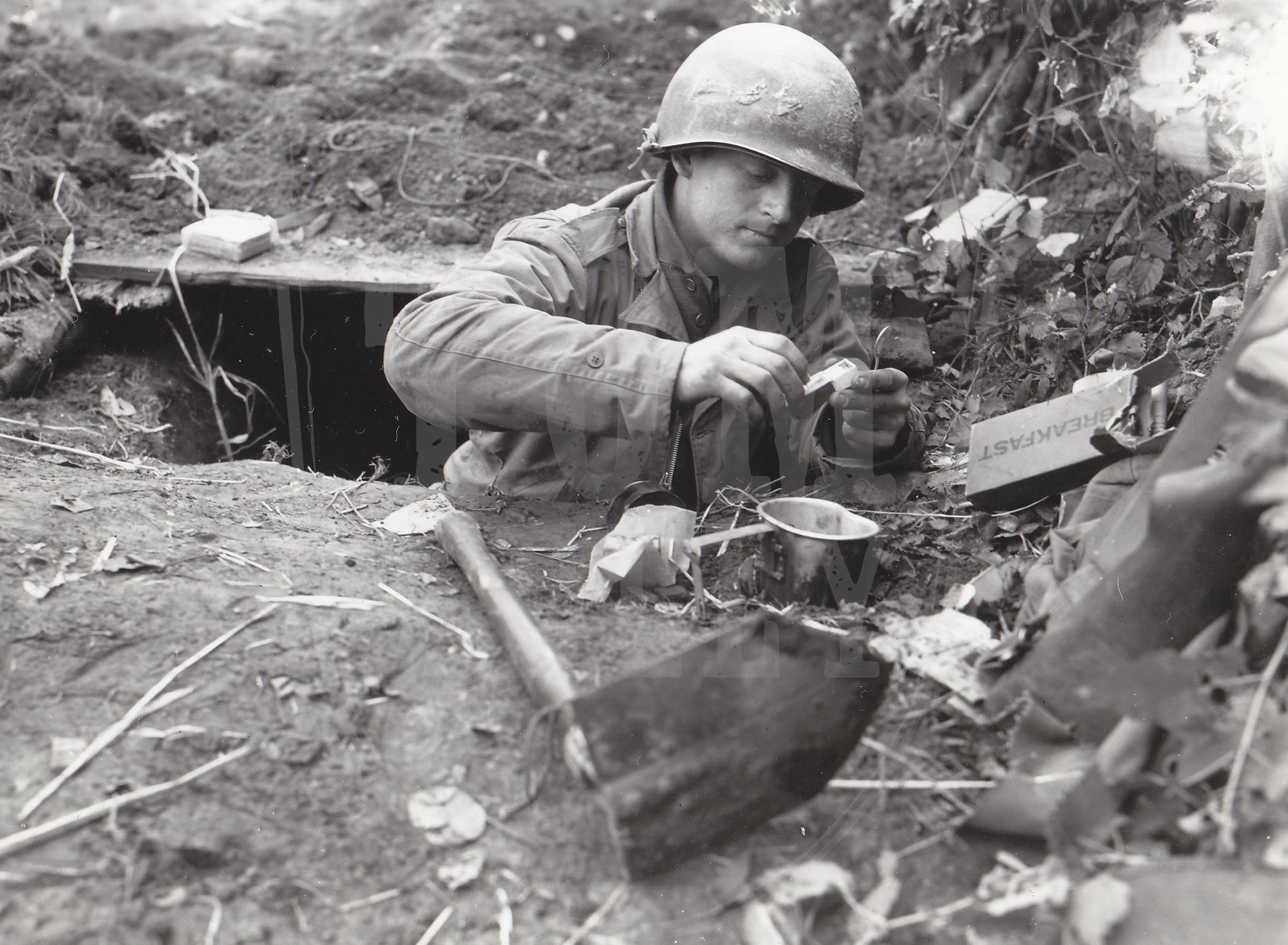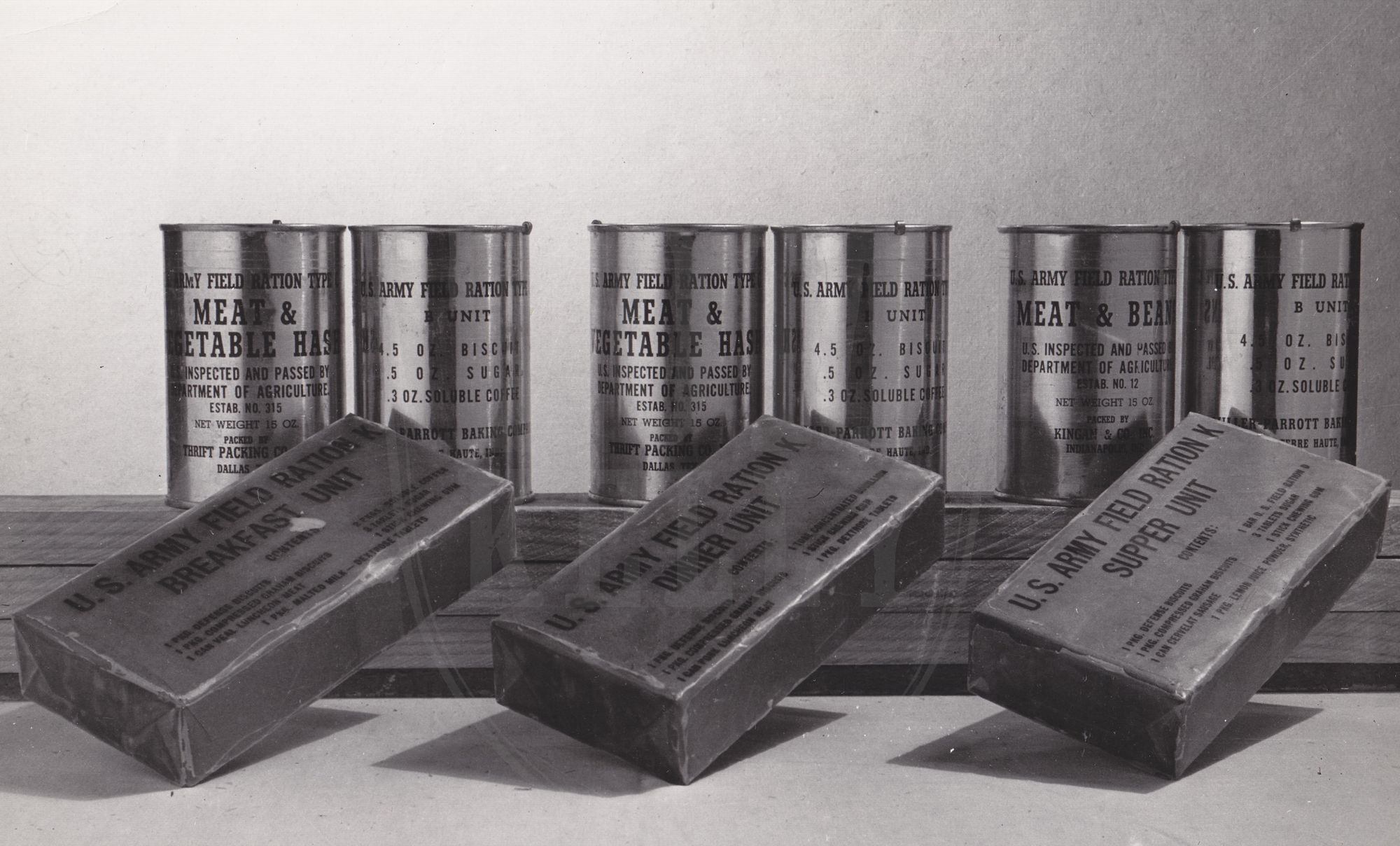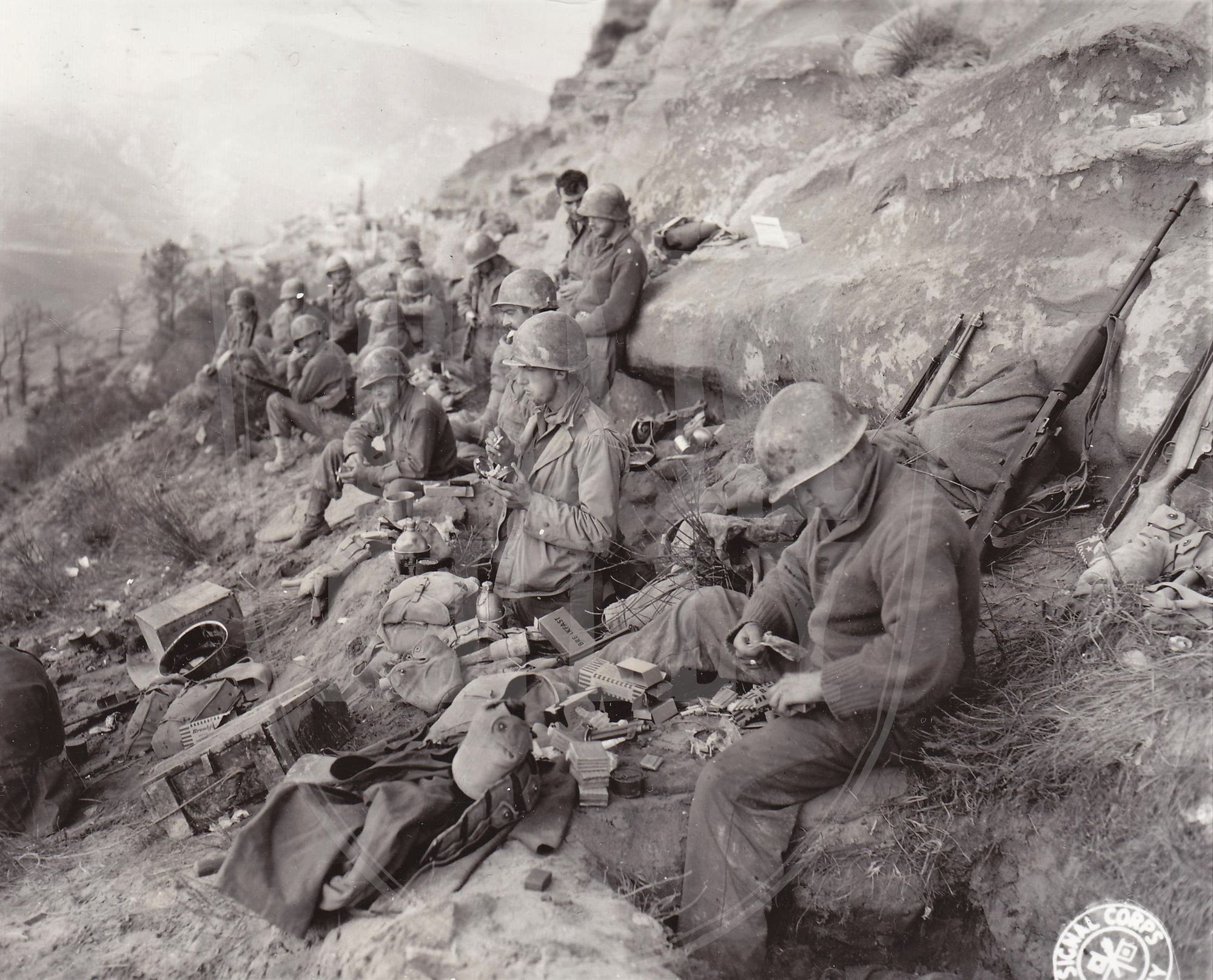In the fall of 1944, John Groth a combat artist for the Chicago Sun, visited the positions of soldiers in the 4th Infantry Division around the Siegfried Line in Germany. He sketched them as they prepared coffee over a Coleman stove and asked, "What do you want me to tell the folks back home?" Corporal Joseph Kemefick of Ilion, New York responded curtly with what Groth considered the "eternal vex" of American soldiers from Normandy to Germany, "Tell 'em to put more coffee in the K rations." [1]

"A soldier in action drinks a lot of coffee"
The combat infantryman's primary source of coffee was from the individual Army combat rations he was supplied, i.e. the canned C Ration and the boxed K Ration. During World War I the Army had experimented with soluble coffee, the result of dehydrating regularly brewed coffee. However, due to its "objectionable flavor" it was not well-received by the soldiers of the American Expeditionary Force or the civilian market. [2] In the years between the world wars the industry improved its processes and products to make better tasting soluble coffee.
In 1940 the Army adopted "Nescafe," a product of Nestle's Milk Products, Incorporated, for its C Ration. Nescafe combined soluble coffee with maltose, dextrine, and dextrole to improve the coffee's taste and aroma. While the government specifications only allowed for "soluble coffee" at the insistence of Army researchers the specifications were revised to allow "soluble coffee and/or soluble coffee product." [3] For the most part, the coffee used during the Second World War was "soluble coffee product" including extracts and other carbohydrates like Nescafe, rather than pure soluble coffee. [4]
While the C Ration was initially provided coffee for each meal that amount was found to be excessive, and by late 1942 the specifications were changed to allow lemon and cocoa powders as substitutes. [5] In contrast, when first adopted, and as produced for the majority of the war, the K-ration only contained coffee in its "Breakfast" variety. The other meals, "Supper" and "Dinner" contained bouillon and fruit juice powder, respectively. [6] Cartoonist and infantry favorite, Bill Mauldin described the much maligned lemon powder as "a mixture of carbolic acid and ersatz lemon powder" wryly suggesting "try drinking that in a muddy foxhole in freezing weather." He likewise disdained the bouillon powder in the Supper ration as "impossible" because it took a lot of water to make it, and "a lot more to drown the salty thirst it causes." [7] Perhaps Technical Sergeant William Davis said it best, "To h— with bouillon and lemonade. How are you going to keep warm at night and stay awake on guard without coffee?" [8]

During the war the Army Quartermaster Corps sent representatives to combat theaters in order to evaluate the items supplied to American soldiers. These observers gathered information on a wide array of items, from uniforms and tents to food. In one of the reports prepared by Quartermaster observers in 1944, a Battalion Commander in the 29th Infantry Division noted that "a soldier in action drinks a lot of coffee." [9] To Marine T. Grady Gallant coffee at breakfast was a morale boosting necessity for troops in combat, without it "the world seems to get off on the wrong foot. Cigarettes don't taste as good, and there is a gnawing feeling something is missing. And, of course, what is missing is the coffee." [10] Quartermaster observers reported that coffee was "an excellent morale factor and stimulant for frontline troops." [11]
Even soldiers who had not been habitual coffee drinkers before entering the service indulged while in combat. A rifleman in the 36th Infantry Division, Bennett J. Palmer, Sr. remembered "had never drunk coffee at home, but it seemed to steady my nerves a bit during the war." [12] Lieutenant Lee M. Otts, of the 26th Infantry Division recalled that "I never drank much coffee at home, but every time I had a chance overseas I would make a cup just to have something inside me." [13]
During periods of heavy combat and rapid advance, particularly following the breakout of the Normandy beachhead, infantrymen could subsist on a diet mainly of, or exclusively of, the more easily carried K Rations. For example, for ten days during the summer of 1944 soldiers in the 3rd Armored Division had nothing but K Rations. [14] Roger P. Casey, a machine gunner in the 30th Infantry Division, recalled the importance of the coffee provided in K Rations:
While the British were tea drinkers, we Americans were coffee drinkers. In the early mornings our 'K' rations [sic] box had a little package of instant coffee. The box itself was wax impregnated and when set on fire would burn slowly and just long enough to heat up a canteen cup of water for our coffee. It was a luxury to us. [15]
By September, combat units in the European Theater of Operations began to bitterly complain of the lack of coffee in their rations, particularly the K Ration. [16]
"We would reach over and relieve a dead man of his breakfast ration, whereas we would not disturb his dinner or supper"
In September 1944, observers reported that in the U.S. First Army (including the 1st Infantry Division, 9th Infantry Division, and 3rd Armored Division), "every officer and enlisted man interviewed suggested that additional coffee units be put in the K ration." Not surprisingly, "it was found with these men the Breakfast Unit [i.e., breakfast K ration] was the most popular." [17] Coffee, according to Lieutenant Paul Boesch of the 8th Infantry Division, "was the one reason the breakfast package was so popular." [18] Charles Davis, a rifleman in the 104th Infantry Division agreed, "It was the breakfast [K] ration that became a premium. That always contained the small envelopes of soluble coffee." [19] Lt. Lee M. Otts, of the 26th Infantry Division recalled that he always carried packets of Nescafe from the breakfast K Ration and that he and other soldiers "bartered them among ourselves." [20]
In October 1944 the Infantry Journal published a letter from an unidentified private who complained:
We, in combat, have to eat C and K rations, but our tastes are absolutely disregarded. Thus, few men eat the dextrose tablets or drink the synthetic lemon juice. Why couldn't C and K Rations contain only a minimum of these articles with so many many throw away and contain more cocoa and coffee as beverages[?] . . . This would greatly reduce wastage and make men more content with their rations. [21]
That same month, Army Quartermaster observers noted again that in the surveyed combat units the breakfast K Ration was the most popular and "a constant request for inclusion of coffee in each unit [of the K ration] is received." [22]
The popularity of the breakfast ration sometimes drove soldiers to extremes to make sure that they obtained them, including removing them from the bodies of dead American soldiers. Boesch recalled that he "saw times during the course of the war when we would reach over and relieve a dead man of his breakfast ration, whereas we would not disturb his dinner or supper." [23] Boesch also noted that he "always had to supervise the handing out of the [K] rations, for if left to his own devices, every man would unashamedly take three breakfast rations. That would mean that the man to be fed last - the hapless lieutenant [i.e. Boesch] - would get three despised dinner boxes." [24]

In some cases, as chronic coffee drinker Walter Brown in the 90th Infantry Division remembered, self-selecting breakfast K Rations was not an issue. Brown disliked the supper ration and one evening when told to draw rations for the next two days, he took four breakfast and two dinner rations. When his buddies asked "how 'n the hell" he got out of taking a super ration, he told them:
'[I] just asked them to hit me twice for breakfast none for supper. No argument at all. If you meat heads had been smart enough, you could have done the same thing. [Why don't] you take yours back and swap? The guys handing them out don't care.' In a few minutes [they] returned with breakfast rations, and looked very pleased with themselves. [25]
"The desire for more coffee"
According to Boesch "no one ever understood why the Army did not see fit to put coffee in all three [K Ration] meals." [26] Boesch's consternation at the Army's lack of coffee in its K rations was not unique. The Observer reports demonstrate that across the European Theater combat troops wanted more coffee, especially in their K rations. One report even references that "many men have written home asking that coffee be sent to them" to make up the deficiency. [27]

One soldier who wrote home for coffee was Lieutenant Mark Gordon Hazard of the 79th Infantry Division. In a letter to his parents dated November 6, 1944 he asked, "If you can find it please send me some soluble coffee, something like Nescafe. If you can get it in small packages send me some at fairly regular intervals." [28]
"More Coffee Going into Army K Ration"
Perhaps because the breakfast was so popular, or generally in response to the clamor for additional coffee in K Rations, on October 31, 1944 the Army changed the specification for the K Ration to include an additional coffee packet in the breakfast ration and included coffee in the supper ration for the first time. [29] This change "as occasioned by developments on the fighting fronts," was later reported in the January 4, 1945 edition of the New York Times. [30]

During the Second World War the Armed Forces, and in particular the Army Quartermaster Corps, continuously sought out ways of improving the weapons soldiers used, the uniforms they wore, and the food they ate. The revision of the K Ration to include more coffee is just one example of the ways in which the Army reacted to information received from soldiers in the field to improve the supplies it furnished them.
Footnotes
[1] John Groth, Studio: Europe, (New York, NY : The Vanguard Press, 1945), 212.
[2] Franz A. Koehler, Coffee for the Armed Forces: Military Development and Conversion to Industry Supply, (Washington, D.C.: Historical Branch, Office of the Quartermaster General, 1958), 39.
[3] Harold W. Thatcher, The Development of Special Rations for the Army, (N.p.: Office of the Quarter-master General, General Administrative, Services Division, Historical Section, 1944), 30.
[4] Koehler, Coffee for the Armed Forces, 40.
[5] Thatcher, The Development of Special Rations for the Army, 30.
[6] Ibid., 56.
[7] Bill Mauldin, Up Front, (New York, NY : Henry Holt and Co., 1945), 168-69.
[8] "Doughboys Want Coffee Included in K Rations," Palladium-Item, November 5, 1944, 12.
[9] Headquarters Communications Zone, European Theater of Operations, Office of the Quartermaster, Quartermaster Field Observation Report No. 14, January 1945. http://cgsc.contentdm.oclc.org/cdm/ref/collection/p4013coll8/id/919 (accessed October 2, 2019).
[10] T. Grady Gallant, On Valor's Side, (New York, NY: Avon Books, 1966), 240.
[11] Headquarters Communications Zone, European Theater of Operations, Office of the Quartermaster, Quartermaster Field Observation Report No. 2, November 28, 1944. http://cgsc.contentdm.oclc.org/cdm/ref/collection/p4013coll8/id/919 (accessed November 10, 2019).
[12] Bennett J. Palmer, Jr., The Hunter and the Hunted: Two Years in a Rifle Company, WWII: Italy, France, Germany, February 5, 1943-October 20, 1945, (Holland, NY: B. Palmer, 2002), 135.
[13] Bruce E. Egger and Lee MacMillan Otts, G Company's War: Two Personal Accounts of the Campaigns in Europe, 1944-1945. Edited by Paul Roley (Tuscaloosa, AL: University of Alabama Press, 1998), 151-52.
[14] Headquarters Communications Zone, European Theater of Operations, Office of the Quartermaster, Quartermaster Field Observation Report No. 1, October 1944. http://cgsc.contentdm.oclc.org/cdm/ref/collection/p4013coll8/id/919 (accessed November 10, 2019).
[15] Roger P. Casey, "Country Boy Goes to War: World War II Memoirs of Roger P. Casey", WWII Papers, Military Collection, Roger P. Casey Papers, 57, State Archives of North Carolina.
[16] The same Observer report indicates that "The same comment as regards additional coffee in the K rations is equally applicable to the C ration," however, the need was more pronounced with the K Ration because of how the C Ration was designed. Unlike the K Ration, which had defined meals, e.g. breakfast, supper, and dinner, until late 1944 the varieties of the C Ration were only distinguished by the contents of the M-unit, e.g. meat and vegetable hash, meat and beans, and meat stew with vegetables. Each C Ration, regardless of M-unit variety, was intended to be issued with a single-type B-Unit containing crackers, and other items like a drink packet which could be either soluble coffee, cocoa mix, or juice powder. Thus, after the Quartermaster reduced the amount of coffee in C Rations in 1942, while C Rations included approximately the same amount of coffee as K Rations, it was less predictable that a C Ration would contain coffee. Observer Report No. 1; Special Rations for the Armed Forces: 1946-53, QMC Historical Studies Series II, No. 6, (Washington, D.C.: Historical Branch Office of the Quartermaster General, 1958), 23; Thatcher, The Development of Special Rations for the Army, 18.
[17] Quartermaster Field Observation Report No. 1.
[18] Paul Boesch, Road to Huertgen: Forest in Hell, (N.p.: CreateSpace Independent Publishing Platform, 2014), 90.
[19] Charles Davis, The Letters of a Combat Rifleman, (Pittsburgh, PA: Dorrance Pub., 2001), 123.
[20] Egger and Otts, G Company's War, 151-152.
[21] "To the Editors," Infantry Journal, October 1944 Overseas Edition, 60. T/5 Raymond E. Sonksen of the 34th Infantry Division put a finer point on the subject in an interview for YANK magazine, "Somebody ought to tell somebody to give us more coffee and lay off the bouillon and lemon powder and cocoa." "Iron Division." YANK The Army Weekly, February 2, 1945, 4. Accessed February 3, 2020, https://www.unz.com/print/Yank-1945feb02-00002/;
[22] Headquarters Communications Zone, European Theater of Operations, Office of the Quartermaster, Quartermaster Field Observation Report No. 3, October 1944. http://cgsc.contentdm.oclc.org/cdm/ref/collection/p4013coll8/id/919 (accessed November 10, 2019).
[23] Boesch, Road to Huertgen, 91.
[24] Ibid.
[25] Walter L. Brown, Up Front with U.S., (Oakland, Me.: W.L. Brown, 1979), 412.
[26] Boesch, Road to Huertgen, 90.
[27] Quartermaster Field Observation Report No. 1.
[28] Hazard, Mark Gordon Hazard, World War II, As I Remember, (West Point, MS: Hazard Cattle Company, 2005), 118.
[29] This specification was known officially as CQD Spec. 28G, Dated October 31, 1944. Special Rations for the Armed Forces: 1946-53, QMC Historical Studies Series II, No. 6, 26.
[30] "More Coffee Going into the Army K Ration," New York Times, January 4, 1945, https://timesmachine.nytimes.com/timesmachine/1945/01/04/306005292.html?pageNumber=31.